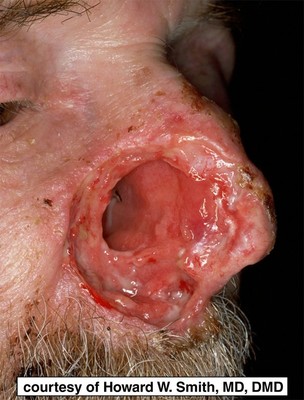Read the following publications:
Menick, F.J. (2010). Nasal reconstruction. Plast Recontr Surg, 125(4), 138e-150e.
Bloom, J.D., Antunes, M.B., Becker, D.G. (2011). Anatomy, physiology, and general concepts in nasal reconstruction. Facial Plast Surg Clin North Am, 19(1), 1-11.
1.
Review the blood supply to the nose.
2.
What are the aesthetic subunits of the nose? Why are they important? How does this apply to nasal reconstruction?
3.
Name some common local flaps used in nasal reconstruction. Be prepared to draw each.
4.
Your FP attending is big on local flaps. Is there a role for skin grafts in reconstruction of nasal defects?
Reference(s):
Sapthavee, A., Munaretto, N., & Toriumi, D. M. (2015). Skin Grafts vs Local Flaps for Reconstruction of Nasal Defects: A Retrospective Cohort Study. JAMA Facial Plastic Surgery, 17(4), 270–273.
5.
A 70-year-old male is referred by a Moh’s surgeon for management of a 1cm full-thickness defect at the tip of his nose. What are the reconstructive options?
6.
The Moh’s surgeon was so impressed by your results in the previous patient, he now sends you a patient with a full nasal alar defect…
Reference(s):
Hatoko, M, Tanaka, A, Kuwahara, M, Tada, H, et al. (2000). An evaluation of hard palate mucosa graft as a lining material in alar reconstruction: a 7-year experience applied to the full-thickness alar defect. Plast Reconstr Surg, 105(6), 1940-7.
Driscoll, B.P., Baker, S.R. (2001). Reconstruction of nasal alar defects. Arch Facial Plast Surg, 3(2), 91-9.
7.
How will you address intranasal lining in your reconstructions?
Reference(s):
Haack, S., Fischer, H., & Gubisch, W. (2014). Lining in nasal reconstruction. Facial Plastic Surgery : FPS, 30(3), 287–299.
8.
Give us the scoop on the midline forehead flap: indications, blood supply, design, stages and timing of each, management of donor site and complications.
9.
Describe the methods available for reconstruction of the bony nasal framework.
10.
Discuss the management of a septal perforation.
11.
Rhinophyma!
Reference(s):
Little, S.C., Stucker, F.J., Compton, A, Park, S.S. (2012) Nuances in the management of rhinophyma. Facial Plast Surg, 28(2), 231-7.
Sadick, H, Goepel, B, Bersch, C, Goessler, U, et al. (2008). Rhinophyma: diagnosis and treatment options for a disfiguring tumor of the nose. Ann Plast Surg, 61(1), 114-20.
12.
Microvascular reconstruction of nasal defects.
Reference(s):
Antunes, M.B., Chalian, A.A.. (2011). Microvascular reconstruction of nasal defects. Facial Plast Surg Clin North Am, 19(1), 157-62.
Menick, F.J., Salibian, A. (2011). Microvascular repair of heminasal, subtotal, and total nasal defects with a folded radial forearm flap and a full-thickness forehead flap. Plast Reconstr Surg, 127(2), 637-51.
13.
A prominent plastic surgeon in the area sends you his post-rhinoplasty complication: soft tissue triangle defect. Fix it.
Reference(s):
Constantine, F. C., Lee, M. R., Sinno, S., & Thornton, J. F. (2013). Reconstruction of the nasal soft triangle subunit. Plastic and Reconstructive Surgery, 131(5), 1045–1050.
14.
Your partner refers this patient. What is your reconstructive plan?


